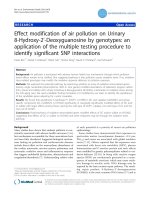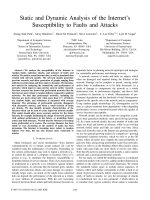TUMORS OF THE PARANASAL SINUSES: APPROACHES TO DIAGNOSTIC IMAGING potx
Bạn đang xem bản rút gọn của tài liệu. Xem và tải ngay bản đầy đủ của tài liệu tại đây (1.3 MB, 41 trang )
Tumors of the Paranasal Sinuses:
Approaches to Diagnostic ImagingApproaches to Diagnostic Imaging
Nir J. Harish
September 2007
Nir Harish, HMS III
Head and Neck Cancers
Oral cavity
Pharynx
Larynx
Nasal cavity
Paranasal sinuses
Salivary glands
Incidence in USA: 45,660/yr
Deaths in USA: 11,210/yr
Nir Harish, HMS III
Head & Neck Cancers
Oral cavity
Pharynx
Larynx
Nasal cavity
Paranasal sinuses: 3% of HNC
Salivary glands
Nir Harish, HMS III
Agenda
Meet the patient: Mr. R
Common signs/symptoms of sinus disease
Radiological Menu of Tests
Normal anatomy
Differential diagnosis
Radiological findings
Companion cases
Putting it all together: Mr. R
Nir Harish, HMS III
Meet the patient: Mr. R
HPI:
57 y/o disabled former electrician c/o
“fullness” in R cheek
PMH:
DM-II, well-controlled on oral medications
HTN
Hyperlipidemia
L3-L4 disc herniation, residual R weakness
S/p cholecystectomy
SHx: Quit smoking 10 yrs ago
Nir Harish, HMS III
Common Signs/Symptoms
“It’s just my sinusitis!”
Nonspecific! Broad indications for imaging.
Think about
origin
and
routes of spread
Sinus symptoms
Nasal stuffiness or discharge
Sinus pain, frontal headache
Cheek discomfort
Facial swelling, pain or numbness
Poor clearing of unilateral “sinusitis” on radiograph
Nir Harish, HMS III
Symptoms of local spread
Into nasal cavity: Unilateral epistaxis
Into orbit: Ocular dysfunction, proptosis,
diplopia
Into oral cavity: Pain/loosening of upper teeth;
“dentures don’t fit”
Into inferior pterygoid muscle: Trismus
Nir Harish, HMS III
Radiologic Menu of Tests
CT:
Modality of choice
MRI:
Complementary
X-Ray
Nir Harish, HMS III
Radiologic Menu of Tests: CT
CT:
Modality of Choice
#1 for both inflammatory and neoplastic processes
Thin sections (3mm), axial and coronal
Evaluates invasion into bony structures
Shows thin septations and air/soft-tissue interfaces
Contrast may be useful in some cases
Limitations
:
Hard to distinguish tumor from soft tissue swelling and
secretions
Radiation exposure
Nir Harish, HMS III
Radiologic Menu of Tests: MRI
MRI:
Complementary
Assessment of soft tissue infiltration, esp intracranial
Multiplanar capability, esp. sagittal
Differentiates neoplasm from adjacent inflammation
No radiation exposure
Gadolinium: correlates with vascularity of tumor
Limitations:
Normal
septae and mucosal layers are undetectable
Malignant osseous lesions are poorly distinguished
Cost
Nir Harish, HMS III
Radiologic Menu of Tests:
Plain Films
X-Ray
No longer preferred
Limited by overlapping structures, especially in
ethmoids/OMC
Used only in ICU settings
Nir Harish, HMS III
Mr. R: Coronal CT
Where is the lesion?
PACS, BIDMC
Nir Harish, HMS III
Mr. R: Coronal CT
R Maxillary Antrum
PACS, BIDMC
Nir Harish, HMS III
Anatomy: Frontal View
From PDRhealth.com
Frontal
Ethmoid
Maxillary
Sphenoid
Nir Harish, HMS III
Anatomy: Frontal View
From PDRhealth.com
Frontal
Ethmoid
Maxillary
Sphenoid
Nir Harish, HMS III
Anatomy: Lateral View
From
Nir Harish, HMS III
Pathways of Drainage
OMC drains:
Frontal
Ethmoid
Maxillary
Sphenoethmoidal
recess
From PDRhealth.com
Nir Harish, HMS III
Plain Film: Waters View
Noyek A.
Head and Neck Radiology.
1991. J.B. Lippincott: Philadelphia.
Nir Harish, HMS III
Plain Film: Waters View
Frontal Sinus
Orbit
Nasal septum
Maxillary Sinus
Maxillary Alveolar
Ridge
Noyek A.
Head and Neck Radiology.
1991. J.B. Lippincott: Philadelphia.
Nir Harish, HMS III
Anatomy on Coronal CT
Schatz CJ, Becker TS.
Radiol Clin North Am.
1984 Mar;22(1):107-118.
Nir Harish, HMS III
Anatomy on Coronal CT
Schatz CJ, Becker TS.
Radiol Clin North Am.
1984 Mar;22(1):107-118.
Cribiform Plate
Frontal Sinus
Temporal Bone
Orbit
Lamina Papyracea
Ethmoid Sinus
Nasal Septum
Maxillary Sinus
Septation
(normal
variant in maxillary sinus)
Maxilla
Tongue
Nir Harish, HMS III
Anatomy on Axial MRI
www.medscape.com
Nir Harish, HMS III
Mr. R: Coronal CT
Mass in floor of
R Maxillary Antrum
PACS, BIDMC
Nir Harish, HMS III
DDx of Paranasal Sinus Mass
Fake-outs
Cyst
Mucosal inflammation
Retained secretions
Benign Tumor
Epithelial
Polyp, Papilloma, Adenoma
Non-epithelial
Fibroma, Chondroma,
Osteoma,
Neurofibroma, Hemangioma,
Lymphangioma
Locally Aggressive Tumor
Inverted papilloma
Angiofibroma
Ameloblastoma
Ossifying fibroma
Giant cell tumor
Malignant Tumor
Epithelial
SCC (most common; 80%)
Adenoid Cystic Carcinoma,
Adenocarcinoma,
Mucoepidermoid Carcinoma,
Undifferentiated
Melanoma
Olfactory neuroblastoma
Non-epithelial
Chondrosarcoma, Osteogenic
sarcoma
Soft tissue sarcomas (e.g.
fibrosarcoma, angiosarcoma)
Lymphoproliferative (e.g.
lymphoma, plasmacytoma)
Metastatic
Nir Harish, HMS III
Radiological Findings
Assess for:
Bone changes
Destruction aggressive process
Look for spread across sinus borders
Bowing slow growth
Foramen enlargement growth along nerve
Sclerotic walls chronic process
Enlargement bone dysplasia or marrow
Fracture
Opacification/decreased aeration
Low uniform density retained secretions
Non-uniform: tumor vs. inflamed mucosa
Masses
Soft tissue, foreign body, calcifications, teeth
Mucosal thickening
Cyst formation
Air-fluid levels









